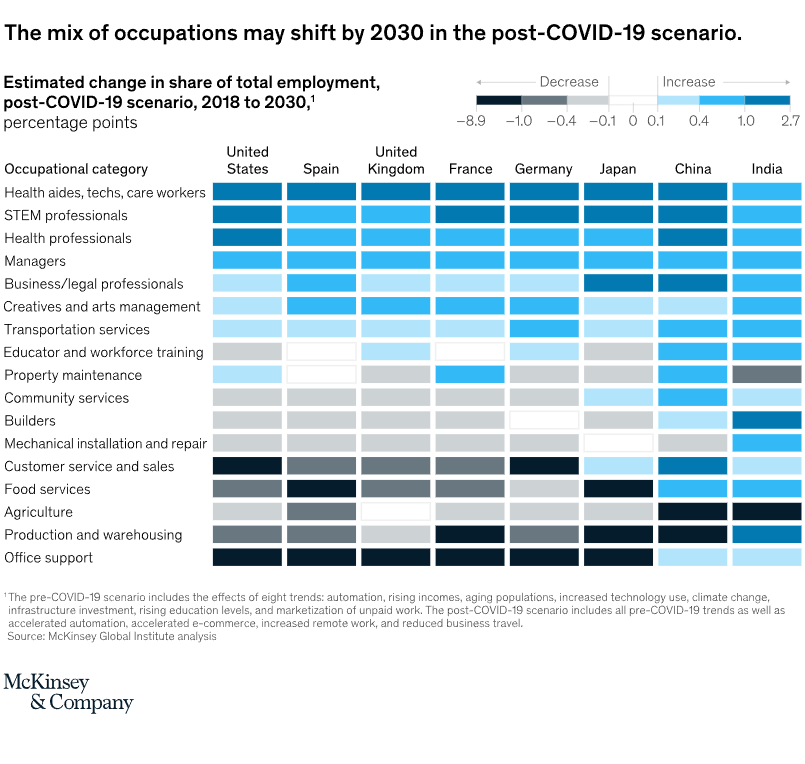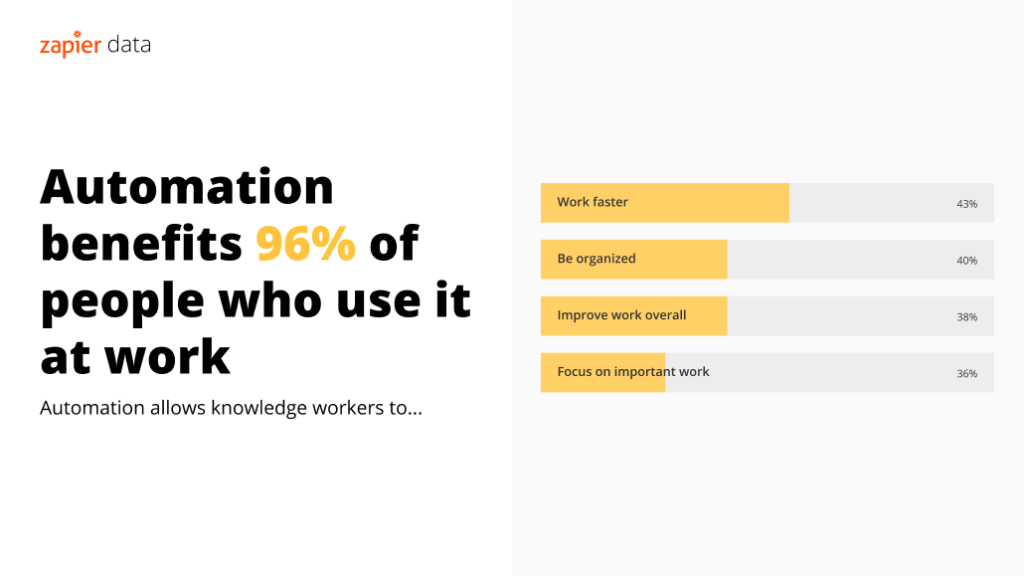The advent of the CoVID-19 pandemic in early 2020 led to a global economic downturn, perpetuating the digital footfall.
As a solution, the traditional operations were slowly replaced with automation used in the workplace, accelerating the growth of digital labor platforms to take up non-traditional work arrangements. This led to a (WFH) work from the home phenomenon, causing many around the world to make their home their office.

It is imperative that firms from all sectors embrace automation in order to achieve value-added work remotely. Industries like healthcare, life sciences, telecommunications, and media had already started to go digital to avoid going out of business.
How Automation Benefits Remote Work
Nearly 64% of knowledge workers use automation software at work and nearly 18% intend to use it in the future. Automation benefits 96% of people who use it. Nearly 43% agree that Automation has helped them complete tasks faster. 40% believe that Automation has helped them to be more organized at their tasks, 38% believe that automation has helped the way they work overall, and 20% believe that their apps work well together due to automation.
They must now focus on adopting full digitization so that their systems can be agile, scalable, and efficient. It would go a long way to enhance patient care while offering more value-added services, along with routine medical tasks.
Here are some of the challenges of WFH and how automation can help to overcome these challenges:
- Productivity
It is important to get your business automated in order to ensure that workflows are efficient, employees are motivated and work is delivered within the timeline. This includes digitizing, structuring, and automating as many business processes as possible. Repetitive tasks can be auto-served and proficient employees will have more time to do the work that really requires creativity, knowledge, and skill.
- Interdepartmental collaboration
In the office, it can be easy to ask colleagues for information or updates, but it becomes challenging to communicate for small queries while working from home. When all digital business data and assets are stored in the cloud, workers can access, edit, and share information in real-time. Because of this, employees can seamlessly work on projects without interruption.
- Work & Time management
Managing teams and tasks while balancing productivity and time efficiently is one of the challenges faced by employees working from home. AI helps your colleagues to keep up with your work timings, and automatically plan and prioritize tasks around everyone’s availability and capacity.
Some of the benefits of integrating AI and automation with your business:
1. System and software integrations
Business process automation can optimize workflows that span through multiple data touchpoints. by syncing data from each touchpoint. Integrating software and systems to business improves accuracy and consistency in operations.
2. Easy accessibility of data
Large enterprises and departments within organizations have made data widely inaccessible. Automation simplifies data maintenance tasks such as modifying and tuning a data center. An enterprise should take advantage of the many tools that facilitate automatically integrating new data sources or migrating data from legacy systems.
3. Track employee progress
Automation enables organizations to streamline and innovate the process of performance management without its inherent challenges. Automating performance management systems can provide real-time constructive feedback of employees, customize & streamline performance processes and help employees and managers refer to past activities & records.
4. Improving customer satisfaction
Automation can help to increase the volume of interactions while simultaneously removing friction and actually improving the service experience for customers. Automation identifies and performs repeatable tasks across the customer engagement cycle and business processes.
5. Improving workforce mobility
This is particularly important for employees who don’t just work from home but are also on the field, such as salespeople, delivery drivers, or field technicians. Real-time remote access to data like customer details, report generation, response & task updates, and work-list can enhance field force productivity, service TAT, and customer satisfaction.
In conclusion, automation has helped provide ease to employees and employers in an efficient way to enrich their business and scale to unprecedented heights. Where standard working days may face turbulence, automation remains a constant.
Kapture and Automation
Kapture CRM is an Enterprise-grade SaaS-based Customer Support Automation platform that provides businesses across industries with all-in-one customer service software. A cloud CRM that’s more than just a help-desk designed to meet the needs of any industry.
- Omni-channel data access
Kapture offers a wide variety of API integrations like Shopify, WooCommerce, Social media, and google play integrations, enabling users to access business process data from multiple channels on a single dashboard. The ideal platform that turns your dashboard into a powerful support center.
- Customer support automation
Kapture CRM enables you to automate email responses & customer profiles. You can auto-assign tasks/tickets by the round-robin method which works on a predefined SLA which improves response time. Kapture helps you to reduce FCR by enabling agents to access customer data from all business functions.
- Field force automation
Kapture’s intuitive mobile app helps simplify your field service challenges. With our field force automation, you can create service plans, assign tasks to your field reps, track their location and availability, close tickets, and complete reports.
- Auto-serve/Self-serve (KMS)
Our knowledge management system helps you create a powerful knowledge center for both your team and customers. KMS provides your customers the option to find quick solutions to their queries by setting up a self-help section specific to their problems and creating an auto-response through chat for their queries. It also helps your agents and customer service representatives to access work and service-related information to handle complex customer queries.
- Agent training and support portal (LMS)
Learning management system helps you create a one-stop centralized knowledge center to auto-train teams. You can enable your employees to upload and share documents detailing business processes. LMS can help improve your employee’s efficiency, knowledge and keep them updated about the new developments.
- Livechat
Live chat enables real-time engagement with your customers and provides instant support. Whether it is WhatsApp, Facebook Messenger, or your own mobile app, our AI chatbot has machine learning-enabled, and can seamlessly interplay with your contact center team and customer details. Through live chat, you can automatically allocate queries sourced from chat, generate reports on queries made on chat, monitor agent’s activities from log-in until log-out, and respond through chat by being in the same ticket thread.

About the Author | |
 | Anunay Shrivastava |
| Anunay Shrivastava, Customer Success manager at Kapture. A Global marketing and advertising awardee with experience in sales, ad-campaign strategies, networking and building partnerships. Inquisitive and tech-savvy individual, worked with tech start-ups from various industries. | |
,
,
,
,
,
,
,
,
,
,
,
,
,







